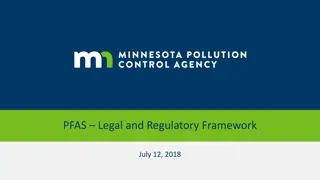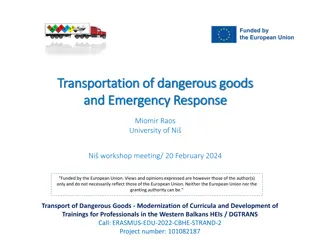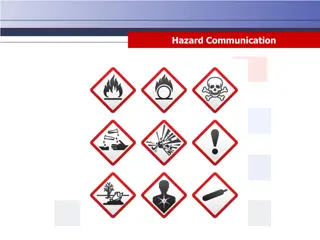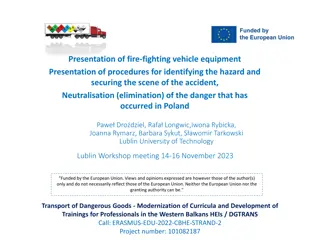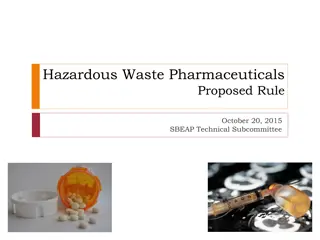Overview of Environmental Health Science and EHS Subfields
Environmental Health Science (EHS) is a vital branch focusing on maintaining resources and improving environmental factors impacting community health. EHS specialists educate, consult, and enforce regulations on various aspects. Subfields of EHS include air pollution, water hygiene, food sanitation,
0 views • 27 slides
Chemical Safety
Dr. Anu George emphasizes the importance of developing a chemical safety plan for handling hazardous substances. The plan includes components like hazard communication, proper labeling, MSDS availability, safe storage and disposal practices, employee training, incident reporting, and record-keeping.
2 views • 43 slides
Enhancing Rail Safety for First Responders: AskRail App Benefits
Freight railroads annually train tens of thousands of first responders, with the AskRail app developed in collaboration to provide immediate information on hazardous materials, safety marks, and UN numbers. The app assists in responding quickly and safely to rail incidents, offering real-time data o
0 views • 21 slides
Comprehensive Guide to Initial Operational Response (IOR) in Hazardous Substance Incidents
This guide outlines the objectives, principles, and key elements of Initial Operational Response (IOR) to incidents involving hazardous substances or CBRN materials. It covers the stages of response, transition to Specialist Operational Response (SOR), primary objectives of IOR, JESIP principles, an
4 views • 25 slides
Environmental Programs Division Off-Project Facility/Borrow Pit Hazardous Materials Questionnaire
The Environmental Programs Division has developed a questionnaire to assist construction partners in selecting off-project locations, such as Borrow Pits, for support activities. The questionnaire focuses on potential environmental concerns related to hazardous materials and encourages compliance wi
4 views • 15 slides
Emergency Services Unit and Hazardous Materials Management in Louisiana
The Emergency Services Unit (ESU) in Louisiana, along with Hazardous Materials management, focuses on preparing, preventing, responding, recovering, and mitigating hazardous incidents. Their goals include public safety through education, training, enforcement, and support of regulations at the state
5 views • 35 slides
PP Jumbo Bags in Hazardous Material Handling
In industries dealing with hazardous materials, safety is paramount. From chemical manufacturing to waste management, proper containment and transportation of hazardous substances are critical to prevent accidents, protect workers, and comply with regulations. This is where PP jumbo bag step in as i
4 views • 5 slides
Occupational Exposure to Hazardous Drugs: Risks and Prevention
Learn about the hazards of exposure to hazardous drugs, including potential health risks such as cancer, nausea, reproductive toxicity, and organ damage. Explore training modules, drug categories, and a list of hazardous drugs to ensure workplace safety. Discover NIOSH criteria for identifying hazar
1 views • 42 slides
Hazardous Drug Cleaning and Decontamination Training Overview
This presentation provides an overview of training on deactivating, decontaminating, cleaning, and disinfecting hazardous drug areas. It covers essential steps, personal protective equipment, materials, timing, and validation criteria. All areas handling hazardous drugs must undergo deactivation, de
0 views • 23 slides
Proposed Amendments for Hazardous Material Release Reporting Regulations
Amendments to the hazardous material release reporting regulations include consolidating definitions, adding new definitions, changing the administering agency, updating citations, and altering notification timeframes. The amendments aim to enhance emergency response and improve reporting procedures
1 views • 18 slides
Best Practices for Laboratory Safety and Management
Promoting a safe laboratory environment involves following safety codes and assigning responsibilities for practices like hazard awareness, equipment use, and PPE. Good laboratory practices include proper storage and handling of hazardous chemicals, with a focus on flammable, corrosive, reactive, an
3 views • 17 slides
Hazardous Materials Awareness Training Overview
This training module provides essential information on shipping and receiving hazardous materials, including definitions, objectives, levels of training required, shipping regulations, and penalties for non-compliance. It covers the importance of training, regulatory guidelines, and the potential co
0 views • 21 slides
Efficient Biomass to Charcoal Technology Philosophy Overview
The technology, initiated in 2012, focuses on high efficiency biomass to charcoal conversion with a robust and simple approach. It emphasizes no hazardous emissions, affordable production costs, and the use of readily available construction materials. The philosophy involves separating heating from
0 views • 20 slides
Hazardous Materials Business Plan Training Program
Facilities subject to the Hazardous Materials Business Plan (HMBP) Program must implement a training program for employees on hazardous materials safety and emergency response. This includes initial training for new employees within 30 days of hire and annual refresher training. Training covers safe
1 views • 73 slides
Understanding Solid Waste Management and Classification
Waste management encompasses a wide range of materials and practices, from solid and liquid waste to hazardous and non-hazardous substances. Learn about different types of waste, sources of waste generation, classifications based on health and environmental impact, as well as origins and types. Expl
0 views • 35 slides
Understanding Materials Science and Engineering Fundamentals
Materials play a crucial role in our daily lives, influencing everything from transportation to communication. This lecture delves into the historical significance of materials, the distinctions between materials science and materials engineering, and the importance of structure-property correlation
1 views • 25 slides
EPA Rule 40 CFR Part 63 Subpart HHHHHH Overview
EPA Rule 40 CFR Part 63 Subpart HHHHHH, also known as The Refinisher Rule, sets standards for hazardous air pollutants in paint stripping and surface coatings operations. The rule aims to control emissions of target hazardous air pollutants in collision centers and surrounding areas. It outlines req
0 views • 20 slides
Safe Handling of Hazardous Drugs: Training and Protocols
This presentation provides guidelines for the safe handling of hazardous drugs during receipt and unpacking. It covers topics such as personal protective equipment, inspecting packages for damage, and proper unpacking procedures. Staff involved in medication handling from suppliers should undergo th
0 views • 16 slides
Overview of PFAS Legal and Regulatory Framework
This document outlines the legal and regulatory framework surrounding PFAS (per- and polyfluoroalkyl substances), including hazardous waste designation, historical context at 3M sites, and the definition of hazardous substances and waste according to Minnesota statutes. It also discusses the potenti
0 views • 19 slides
Hazardous Drugs Spill Control and Clean-Up Guidelines
Learn about safe handling of hazardous drugs through spill control and clean-up procedures. This presentation covers identifying spills, using spill kits, cleaning spills, reporting, and documentation. Proper training and procedures are essential to protect personnel from exposure risks. Always foll
0 views • 27 slides
Hazardous Plants Identification and Safety Guide
Explore the five main hazardous plants found in and around Peterborough County, including stinging nettle, poison ivy, poison sumac, wild parsnip, and giant hogweed. Learn about their distinct features, hazardous parts, symptoms of contact, and safety precautions. Discover how to identify these plan
0 views • 4 slides
Safe Handling of Hazardous Drugs: Training Overview
This presentation provides essential information on safe handling practices for transporting hazardous drugs within healthcare facilities. It covers training modules, types of transport activities, personal protective equipment requirements, packaging guidelines, and safety criteria for labeling and
0 views • 17 slides
Understanding Hazardous Materials Transportation Regulations
Legislation governs the transportation of hazardous materials, including strict rules for packaging and transport. Dangerous goods are classified into nine categories, each with specific hazards. Consignors must identify, label, and package goods properly to prevent risks. Biological materials requi
0 views • 9 slides
Hazardous Waste Management Regulations in Pennsylvania
The hazardous waste management regulations in Pennsylvania outline compliance standards for handling hazardous waste, including storage, identification, transportation, recordkeeping, and emergency response. These regulations incorporate both federal guidelines under RCRA and state-specific requirem
0 views • 122 slides
Effective Hazardous Waste Management Strategies for Electronics and Batteries
Implementing proper waste management strategies for electronics and batteries is crucial to promote recycling and prevent environmental harm. The policy outlines procedures for disposing of electronic waste, including the collection of usable equipment for surplus handling. Additionally, it emphasiz
0 views • 9 slides
Proper Handling and Disposal of Hazardous Drugs and Waste
Guidelines for the safe handling and disposal of hazardous drugs and waste in healthcare facilities. The content covers training modules, waste collection, sources of healthcare waste, disposal methods, and legal regulations related to the disposal of hazardous drugs. Various types of healthcare was
0 views • 21 slides
Modernization of Curricula for Transportation of Hazardous Materials and Emergency Response Workshop
This workshop, funded by the European Union, focuses on modernizing curricula and developing training programs for professionals in the Western Balkans HEIs on the transportation of dangerous goods and emergency response. Various methods of transporting hazardous materials, such as cargo tanks, chem
0 views • 35 slides
Importance of Hazard Communication Training for Workplace Safety
Hazard communication training is essential for creating a safe work environment by helping individuals recognize and manage hazardous materials effectively. Understanding the Globally Harmonized System (GHS) and following hazard communication laws can improve workplace safety, protect human health,
0 views • 36 slides
Proper Procedures for Dealing with Hazardous Substance Spills
This presentation covers the procedures for identifying and securing hazards at the scene of an accident, as well as neutralizing dangers in Poland. It includes information on fire-fighting vehicle equipment, such as different nozzles and tools used by the fire brigade. Steps for dealing with hazard
0 views • 7 slides
Ensuring Chemical Reporting and Preparedness at the DEQ
The Chemical Reporting and Preparedness section at the DEQ focuses on regulations under EPCRA, prompted by incidents like the Bhopal tragedy. EPCRA covers Tier II reporting, spill reporting, LEPCs, State Emergency Response Commission, and Oklahoma Hazardous Materials Emergency Response Commission. T
0 views • 17 slides
Hazardous Waste Pharmaceuticals Proposed Rule Overview
This briefing provides an in-depth look at the Hazardous Waste Pharmaceuticals Proposed Rule from October 20, 2015. It covers which pharmaceuticals are considered hazardous waste, major provisions of the proposal, examples of listed hazardous waste pharmaceuticals, and the flow of hazardous waste ph
0 views • 40 slides
Occupational Safety Training in Handling Hazardous Drugs
This presentation provides guidelines and training modules for staff responsible for cleaning areas where hazardous drugs are handled, including laundry and housekeeping tasks. Topics cover personal protective equipment recommendations, cleaning procedures, disposal processes, and hygiene practices.
0 views • 18 slides
Hazardous Materials Safety Guidelines for Room XXX in Building
This document outlines the hazardous materials safety guidelines for Room XXX in the building, highlighting prohibitions on eating, drinking, and smoking, as well as the requirement for safety glasses. It includes contact information for primary and secondary area contacts, the department head, and
0 views • 4 slides
Understanding Rheology in Dental Materials
Rheology is a crucial aspect in dentistry as it deals with the flow properties of various dental materials, including liquids like molten alloy and impression materials. Viscosity plays a key role, determining how materials flow and behave. Different fluid classifications based on rheology, such as
0 views • 15 slides
Hazardous Waste Facility Parceling Process
Hazardous Waste Facility Parceling involves subdividing permitted facilities into separate property tracts to facilitate ownership transfers. The process allows for the transfer of portions of the property, including hazardous waste management units, with specific actions and requirements for new ow
0 views • 5 slides
Guidelines and Regulations for Science and Engineering Fair Projects
Ensure completeness of required forms before conducting any experimentation for the Collier Regional Science and Engineering Fair. Local rules take precedence over state and international rules. Projects involving vertebrate animals, hazardous biological agents, or chemicals require approval from th
0 views • 13 slides
Youngstown State University Hazardous Waste Program Overview
The Hazardous Waste Program at Youngstown State University follows a cradle-to-grave approach, encompassing laws, regulations, inspections, roles, and responsibilities related to hazardous waste management. It delves into the identification, labeling, disposal, and transportation of hazardous waste,
0 views • 18 slides
Workplace Safety Guidelines and Objectives
This content provides comprehensive information on workplace safety, including general safety rules, evacuation routes, use of safety equipment, personal protective equipment, hazardous materials safety, and first aid principles. It emphasizes the importance of maintaining a safe work environment, i
0 views • 54 slides
RIPA Technical Meeting Grand Rapids, MI
The Pipeline and Hazardous Materials Safety Administration's (PHMSA) strategic framework emphasizes innovation and safety in transportation of energy and hazardous materials. Goals include cultivating excellence, building trust, and pursuing operational excellence. Initiatives such as IBC repair tes
0 views • 11 slides
Safe Transportation of Hazardous Materials: A Comprehensive Guide
This comprehensive guide explores the safe transportation of hazardous materials, covering topics such as requirements for hazmat drivers, classifications of hazardous materials, handling procedures, placarding, and regulatory compliance. Learn about identifying, packaging, labeling, and transportin
0 views • 31 slides


















